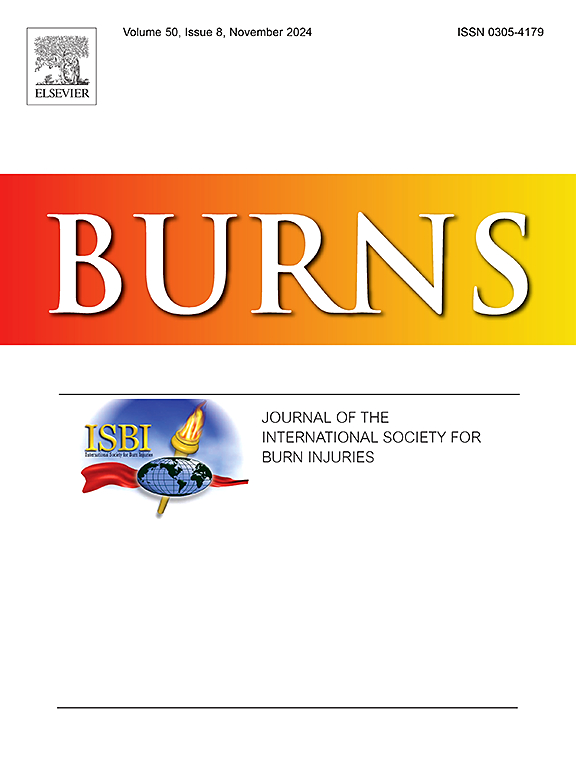Effect of nature-based sounds on pain and anxiety during dressing changes in hospitalized burn patients: A randomized controlled clinical trial
IF 2.9
3区 医学
Q2 CRITICAL CARE MEDICINE
引用次数: 0
Abstract
Background
Burn injuries are associated with severe pain and anxiety, particularly during dressing changes. This study aimed to evaluate the effects of nature-based sounds (N-BSs) in alleviating pain intensity and anxiety levels in hospitalized burn patients.
Methods
This single-center, randomized controlled clinical trial enrolled 86 adult burn patients in Arak, Iran, between December 2023 and June 2024. Of these, 84 patients completed the study (2 withdrawals). Participants were randomly assigned to an experimental group (a 30-minute N-BS session during dressing changes) or a control group (regular dressing changes). Pain intensity (Visual Analog Scale [VAS]) and anxiety (State-Trait Anxiety Inventory [STAI-S]) were assessed before and after the intervention. Data were analyzed using Chi-square, t-tests, and paired t-tests (P < 0.05).
Results
At baseline, there were no significant between-group differences in pain (P = 0.96; 95 % CI [−9.31, 0.98]) or anxiety (P = 0.63; 95 % CI [−4.96, 3.01]). Post-intervention, the N-BS group demonstrated a significant within-group reduction in pain (P < 0.001; 95 % CI [0.57, 1.90]; effect size=0.58), whereas the control group did not (P = 0.12; 95 % CI [-0.12, 0.97]). However, between-group analysis showed no statistically significant difference in post-intervention pain (P = 0.06; 95 % CI [-0.61, 1.72]) or anxiety (P = 0.80; 95 % CI [-4.36, 3.36]). Analgesic consumption was also comparable between the two groups (P > 0.49).
Conclusion
A single-session N-BS intervention may offer limited clinical benefits for pain and anxiety during dressing changes in burn patients. Future studies should investigate extended exposure durations, repeated sessions, and personalized stimuli to optimize the efficacy of N-BS in burn pain and anxiety management.
基于自然的声音对住院烧伤患者换药期间疼痛和焦虑的影响:一项随机对照临床试验
背景:烧伤与剧烈疼痛和焦虑有关,特别是在换药时。本研究旨在评估基于自然的声音(N-BSs)在缓解住院烧伤患者疼痛强度和焦虑水平方面的作用。方法:这项单中心随机对照临床试验于2023年12月至2024年6月在伊朗阿拉克招募了86名成年烧伤患者。其中,84例患者完成了研究(2例退出)。参与者被随机分配到实验组(在换药期间进行30分钟的N-BS会话)或对照组(定期换药)。干预前后分别评估疼痛强度(视觉模拟量表[VAS])和焦虑程度(状态-特质焦虑量表[STAI-S])。采用卡方检验、t检验和配对t检验对数据进行分析(P 结果:在基线时,组间疼痛(P = 0.96;95 % CI[-9.31, 0.98])或焦虑(P = 0.63;95 % CI[-4.96, 3.01])无显著差异。干预后,N-BS组疼痛明显减轻(P 0.49)。结论:单次N-BS干预可能对烧伤患者换药期间的疼痛和焦虑提供有限的临床益处。未来的研究应该研究延长暴露时间、重复疗程和个性化刺激,以优化N-BS在烧伤疼痛和焦虑管理方面的疗效。
本文章由计算机程序翻译,如有差异,请以英文原文为准。
求助全文
约1分钟内获得全文
求助全文
来源期刊

Burns
医学-皮肤病学
CiteScore
4.50
自引率
18.50%
发文量
304
审稿时长
72 days
期刊介绍:
Burns aims to foster the exchange of information among all engaged in preventing and treating the effects of burns. The journal focuses on clinical, scientific and social aspects of these injuries and covers the prevention of the injury, the epidemiology of such injuries and all aspects of treatment including development of new techniques and technologies and verification of existing ones. Regular features include clinical and scientific papers, state of the art reviews and descriptions of burn-care in practice.
Topics covered by Burns include: the effects of smoke on man and animals, their tissues and cells; the responses to and treatment of patients and animals with chemical injuries to the skin; the biological and clinical effects of cold injuries; surgical techniques which are, or may be relevant to the treatment of burned patients during the acute or reconstructive phase following injury; well controlled laboratory studies of the effectiveness of anti-microbial agents on infection and new materials on scarring and healing; inflammatory responses to injury, effectiveness of related agents and other compounds used to modify the physiological and cellular responses to the injury; experimental studies of burns and the outcome of burn wound healing; regenerative medicine concerning the skin.
 求助内容:
求助内容: 应助结果提醒方式:
应助结果提醒方式:


